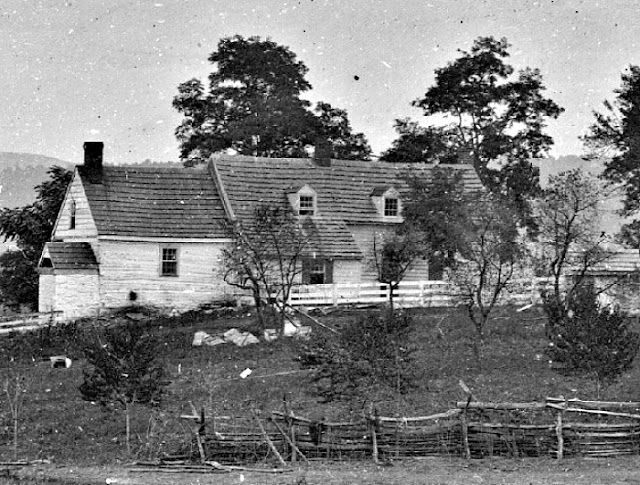 |
| William Roulette lived here with his wife and five children in 1862. Renowned Civil War photographer Alexander Gardner took this image. (Library of Congress collection) CLICK ON IMAGE TO ENLARGE. |
Broken fence rails may be seen near Roulette's house as well as in back of it in the field at the far left. Although damage from rifle and artillery fire is not apparent in the image of the farmhouse, accounts note that the house was struck many times. According to this 1891 account, "one huge shell tore through the west side, a little above the floor, and going through the parlor in an upward course passed through the ceiling and a wall beyond and fell harmless among a heap of rubbish it had created."
Roulette's house, shown here in an interactive panorama that I shot in the spring, and nearby barn were used as field hospitals during and after the battle. The rug in Roulette's parlor was so soaked with blood that it later had to be washed in nearby Antietam Creek.
The Union army's II Corps, including the 14th Connecticut, swept across Roulette's property to attack the center of the Rebels' line at nearby Bloody Lane. What may be farm animals, perhaps cows, appear in an enlargement at the very bottom of this post.
Roulette's property was stripped of anything that could be used to fuel the Union army, including livestock, so the enlargement may not show what I think. Months after the battle, Roulette submitted a lengthy itemized list to the U.S. government requesting compensation for damage the battle had caused to his property. One item found on the list: “Beehives + Bees = $8.00."
 |
| An enlargement of Gardner's image shows what may be Roulette's beehives, which were overturned during the battle. The bees swarmed over soldiers in the 132nd Pennsylvania, causing great confusion. |
 |
| In another enlargement of Gardner's image, broken fence rails, undoubtedly caused by soldiers, can be seen in the distance. (CLICK ON IMAGE TO ENLARGE.) |

No comments:
Post a Comment